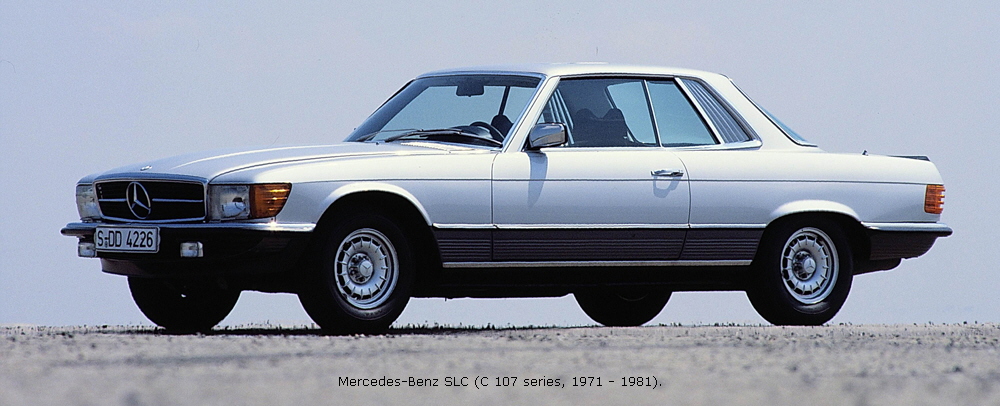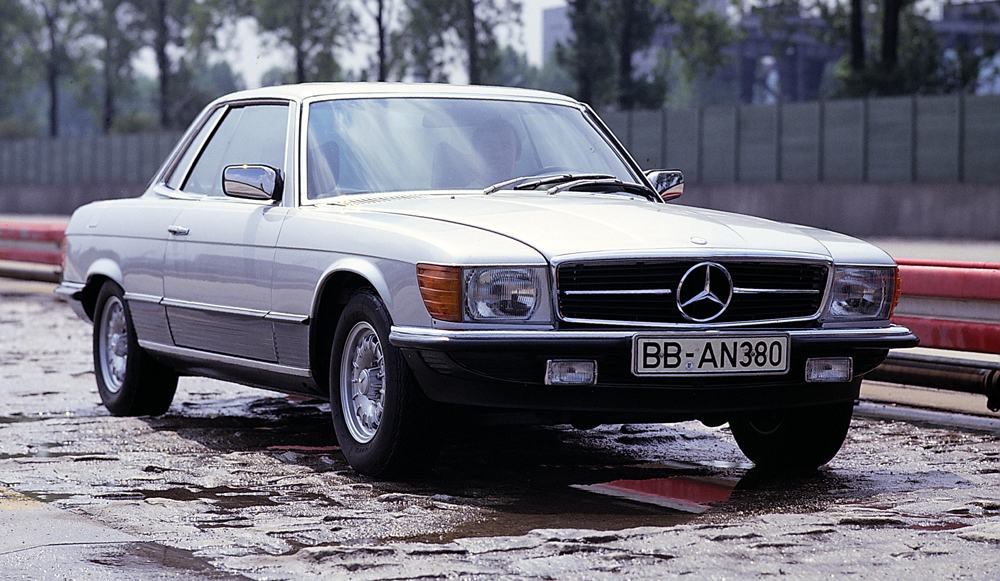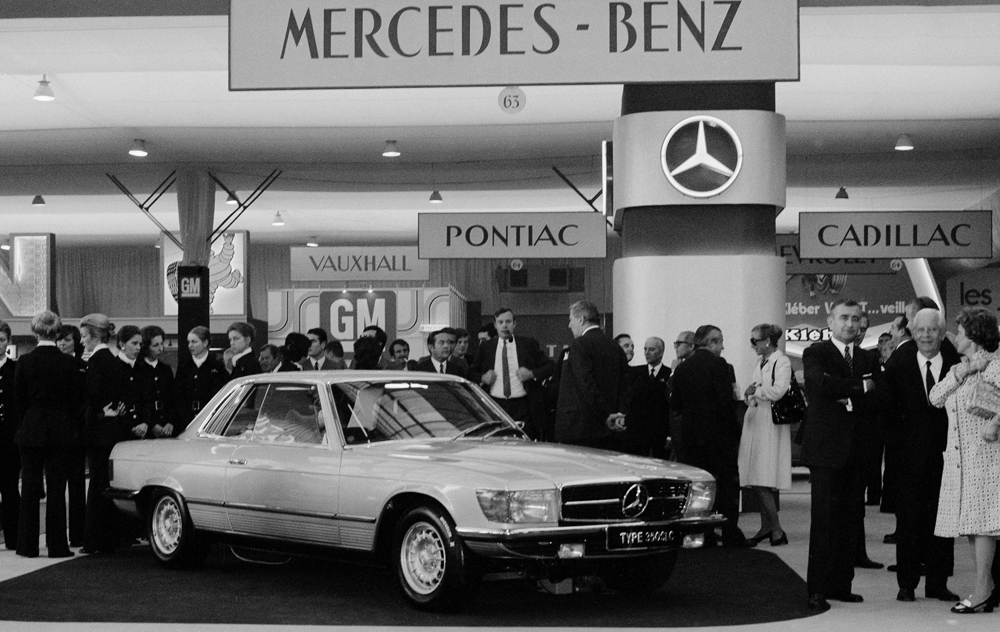|
|
|
Mercedes-Benz SLC models of the C 107 series (1971 to 1981) Coupés based on a touring sports car When the new touring sports car of the R 107 series was presented in April 1971, the issue of whether to a new large Coupé should be developed at Mercedes-Benz still remained unanswered. Discussion centred on whether one should additionally, and in the near future, design a four-seater sports coupé based on the R 107 series, or wait for the coming S-Class (116 series) to build it on that basis. But in that case a production model would not have arrived until much later, in the mid-1970s. Karl Wilfert, then the head of Body Design in Sindelfingen, developed – pretty much on his own authority – a Coupé based on the R 107 and presented it one day to the Board of Management as a "rough draft". Rejected at first, Wilfert managed to push through his idea of a sports Coupé with the tenacity which was so characteristic of him. And so six months after its premiere the SL Roadster was followed in October 1971 by a comfortable four-seater Sports Coupé, the 350 SLC, whose unconventional lines also found it many friends around the world in the course of the years. The series was given the internal designation C 107. The open-top vehicles of the SL series as a basis The technical basis was the SL series R 107. This touring sports car was a powerful, self-confident and representational open-top vehicle, which had additionally been equipped with an equally successful detachable Coupé roof by its designers. In addition to elegance and safety, the body also exuded safety, since the two-seater's crash behaviour was already well ahead of its time. The decision to manufacture the R 107 series ("R" as in Roadster instead of "W" as in Wagen = car) was taken by the Board of Management after intensive debates on 18 June 1968. At dispute was whether there should be a Targa-roof version, i.e., one with a removable roof panel, instead of the fabric-topped variant, because owing to higher safety standards alarming news was to be heard from the USA regarding the licensing of open-top cars. The head of development at the time, Hans Scherenberg, pushed through the decision to go ahead with an open-top two-seater with a fabric roof and an additional removable hardtop. Up to the windscreen its appearance matches that of the open-top variant; behind the windscreen the overall height and length grows. A flat roof spans the four-seater passenger compartment in a gentle curve, going over into a large and very steep rear window that arches in two directions. The boot lid is slightly convex in shape, unlike that of the SL. In the side view the length of the Coupé is documented, firstly, by the 360 millimetre longer wheelbase (2820 millimetres versus 2460), secondly by the line of the side windows. Without awkward B-pillars they are completely retractable, as is usual in a Mercedes-Benz Coupé. The SLC's coefficient of drag is better than that of the SL so that the Coupé attains the same performance despite an added weight of some 50 kilograms. A particularly noteworthy fact is that it fully lived up to its classification as a "Sports Coupé", gaining wins for Mercedes-Benz in many rallies and long-distance races. Safety as a matter of course Béla Barényi's safety concept with front and rear crumple zones and a rigid passenger cell found expression in the 107 series in a further developed form. The backbone of the R 107 series is not simply a shortened and reinforced Saloon floor assembly, as in the predecessor, but an independent frame-floor unit with a closed transmission tunnel and box-shaped cross and longitudinal members which featured differing sheet metal thicknesses and a resultant carefully defined crumple pattern. The SL definitely had to be an open-top car, and that being the case the only protection in a possible roll-over would be provided by the In the interior the hard dashboard made way for an ingenious sheet-steel design that yields on impact both in the top section and the knee area and is foam-padded. The switches and levers were recessed. Another new feature: the four-spoke steering wheel based on the latest findings of accident researchers. The proven impact absorber was still in place, but the steering-wheel rim, spokes, padded boss and hub were covered with polyurethane foam. As further safety feature the fuel tank was no longer installed in the rear end but above the rear axle, protected against collision. The anti-lock braking system ABS was available from March 1980. Characterful Coupé with innovative details Like the Roadster, the Coupé met with a very favourable response. Its distinctive front end with the dominant SL face, the wide-band headlamps and grooved indicator covers had a powerful aura; the lines of the low silhouette were harmonious. The wide-band tail lights with their ribbed surface not only were largely insensitive to soiling, but additionally gave the rear end a touch of vigour. A number of details underscored the car's safety aspirations. The seats were available from the start with head restraints, and seat belts also were included. Physical well-being and driver-fitness safety were served by the heating system with its very spontaneous response, supported by new air ducting at the doors. Newly developed wind-deflecting mouldings on the A-pillars, which also served to channel off mud-laden water in the rain, and dirt-repelling covers on the exterior mirrors enabled good visibility. They kept the side windows clean even in inclement weather. The windscreen wipers arranged closely to each other in the centre of the car swept a respectable 70 percent of the windscreen area, were always optimally positioned in the flow of air and did not lift off even at higher speeds. Varied range of engines On account of its shorter production period and the fact that the 450 SLC 5.0 was only available as a Coupé, the range of engines in the C 107 series was different to that of the R 107 series. The eight-cylinder models were led by the 350 SL (1971 to 1980), whose 3.5-litre engine (M 116) already was known from the W 108, W 109 and W 111 series. The 147 kW which it delivered at 5800 rpm helped the SL, which tipped the scales at around 1600 kilograms, to clock nine seconds for 0 to 100 km/h with a top speed of 210 km/h. Then in 1972 Mercedes-Benz launched the 450 SLC, whose engine (M 117) developed an output of 165 kW at 5000 rpm. Top speed was 215 km/h, and it needed 8.8 seconds to go from 0 to 100 km/h. Like the 450 SL, the 450 SLC was destined exclusively for export to North America prior to March 1973; after that Mercedes-Benz included them in the general sales range. In July 1974 the SL model range was extended: as a consequence of the oil crisis of 1973, the SL and SLC now were available as models 280 SL and 280 SLC with the 2.8-litre M 110 engine. It developed 136 kW at 6000 rpm and had proven its reliability in the two years before in the "Stroke Eight" series W 114/115 and in the 116-series S-Class. Both models had identical performance: the top speed was 205 km/h; sprinting from 0 to 100 km/h in 10.1 seconds was possible. So three SLC engine variants were now available. Only the attentive observer could distinguish between the three variants: The 280 SL could be recognised by its narrower tyres in comparison to the 350 SLC and the 450 SLC. In addition, the 450 SLC featured an inconspicuous front spoiler which was attached to the rear lower end of the front apron and distinctly increased the radiator's air throughput. Between November 1975 and February 1976 the fuel injection systems of all three engines were changed for better compliance with the emission
standards, which meanwhile also had become stiffer in most European countries. The electronically controlled Bosch D-Jetronic was abandoned for the newly developed mechanically controlled Bosch At the same time the compression ratios of the 2.8 and 3.5-litre engines were slightly reduced. The 3.5 and 4.5-litre engines additionally got a contactless transistorised ignition and hydraulic valve play compensation to facilitate maintenance. The compression ratio of the 2.8-litre unit was raised to the old figure again in April 1978. With a few supporting measures the engine then regained its earlier power potential of 136 kW, but now already at 5800 rpm. In September 1977 Mercedes-Benz launched the 450 SLC 5.0 with a V8 engine (M 117) enlarged to a displacement of five litres. A hidden innovation was the first-time application of hypereutectic cylinder contact surface machining, which made it unnecessary to insert cylinder liners. The engine delivered 177 kW at 5000 rpm, good for zero to 100 km/h acceleration in 8.5 seconds and a top speed of 225 km/h. The vehicle's bonnet and boot lid were made of aluminium, and it had light-alloy wheels as standard. On the outside, the 450 SLC 5.0 was recognisable by, among other things, a narrow spoiler on the rear end. This model had no roadster equivalent. Series revision At the Geneva Motor Show in March 1980 the SLC and SL series presented themselves in updated form. The interior appointments including steering wheel were matched to those of the 126-series The six-cylinder engine of the 280 SLC remained unchanged. The 350 SLC was sent off into retirement and succeeded by the 380 SLC, whose 3.8-litre light-alloy engine (M 116), with 160 kW at 5500 rpm, originated after the pattern of the five-litre unit, by enlarging the bore of the long-serving 3.5-litre V8 with grey cast iron cylinder block. The 380 SLC attained a top speed of 215 km/h and needed nine seconds for the sprint from 0 to 100 km/h. Parallel to the introduction of the new 500 SL, which was fitted with the 5.0-litre V8-engine (M 117) from the 450 SLC 5.0, the Coupé was renamed the 500 SLC. All three SLC models were now equipped with the light-alloy bonnet and front spoiler familiar from the 450 SLC 5.0, while the light-alloy boot lid with black plastic rear spoiler remained reserved for the top-of-the-range model. The successors to the C 107 series, the 380 SEC and 500 SEC of the C 126 series, were presented at the Frankfurt International Motor Show in September 1981. During its ten-year period of production a total of 62,888 examples of the SLC Coupé were built.
Mercedes-Benz 450 SLC 5.0 (C 107 series, 1971 - 1981) on the test track at Untertürkheim.
Mercedes-Benz 350 SLC (C 107 series, 1971 - 1981) at the Paris Motor Show of 1971.
|
|
Home < Mercedes-Benz < Mercedes-Benz Cars < Historical Models < 1979-1960
|


